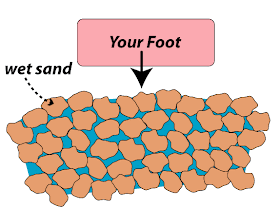Why does wet beach sand look dry in front of your footprint?
Is one of those fun, yet hard-to-conceptualize questions that requires a little understanding of how granular materials behave. In particular, the behavior of saturated sand. The process that makes the wet beach sand look "dry" when you step on it is called dilatency. You step on the saturated sand and some of the sand gets "squished" beneath your feet. Some of the sand is compressed downwards - but, due to the granular behavior of sand, some of it is forced sideways (in a process called "lateral yielding") and this sand forces some additional grains to get shoved upwards. The spot away from your foot is not being forced down, so it's easier for the sand to be pushed upwards to make room for all this sand forced out sideways.
The small spaces (interstices) between sand grains that are forced out and up become larger (dilatency) - more space between grains means that the water can't fill those other spaces and the sand appears dry. See the illustration below:

Since water fills all the open space between the grains, the sand appears dark and wet. You push down on the sand with your foot, and force the sand outwards:

The grains forced out and up now appear dry - there isn't water between those grains (thanks in part to gravity and the lack of sufficient surface tension in water to pull it up into those spaces). If you stop moving, or take your foot away, you may notice that some of the sand "sinks" back downwards as the grains re-arrange themselves again, allowing the grains to settle together and the water re-fills those empty spaces.
If you try this on mud - it doesn't have the same effect. Clay particles behave quite differently compared to sand-sized particles. But that's a post for another time. For now, it's important to note that the behavior of granular materials like sand depend largely on the contacts between individual grains. This "internal friction" helps sand stay in a pile (it's angle of repose), but when they are saturated (when all the voids are filled with water), this friction essentially disappears. The sand is now very susceptible to external stresses (like your feet) and move easily. Thus, when anyone claims that the Coconino (and other large sandstone formations) was deposited in sea water, then eroded prior to lithification has either not walked on the beach, or does not fully understand the behavior of saturated sands.
Which reminds me - I need to spend some time talking about things like "lithification" and "consolidation" since these terms are often mis-used or conflated. They are two different processes - sometimes related, but they imply rather different behaviors.











